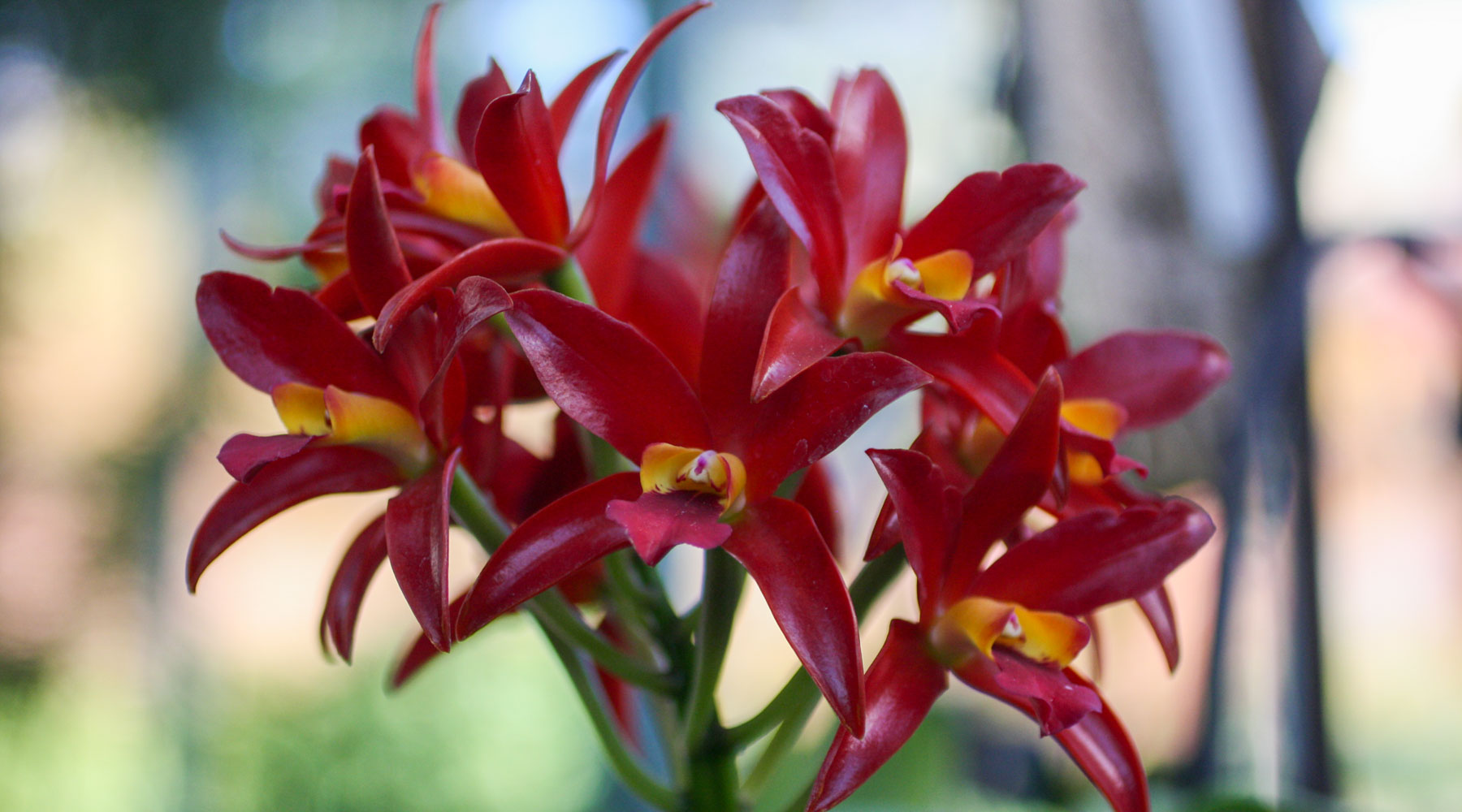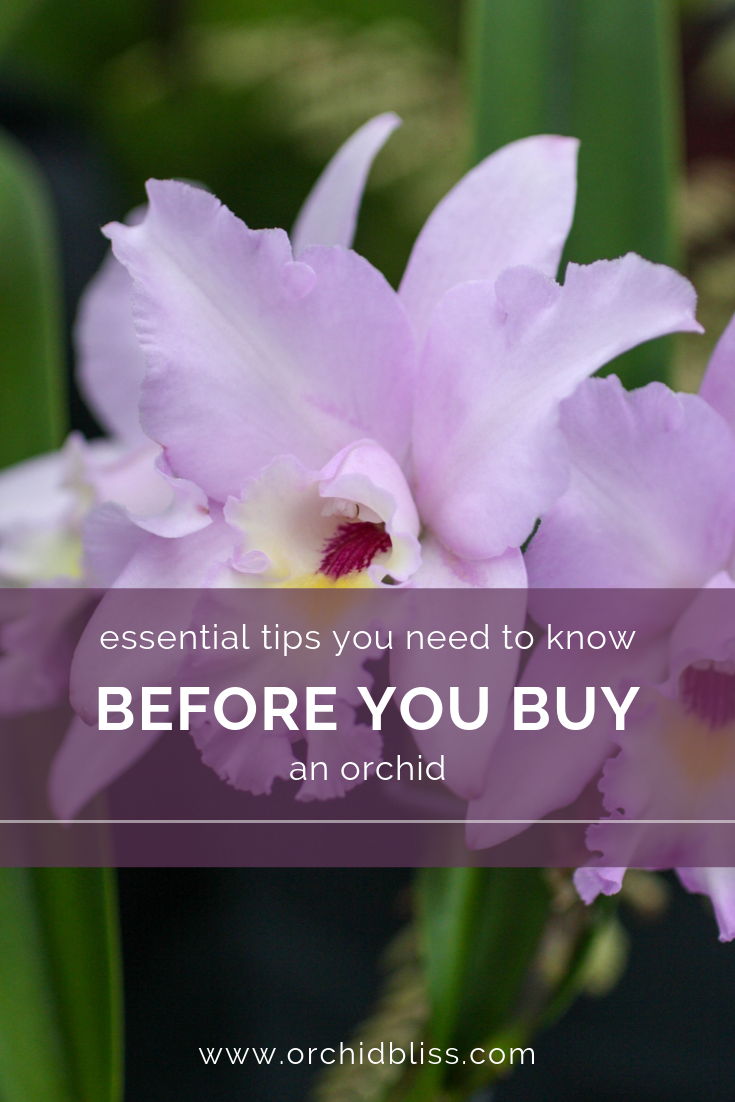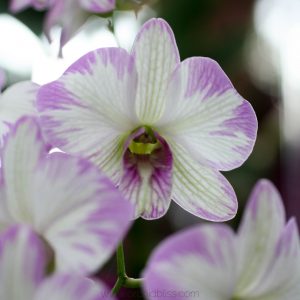
What You Need to Know & Do BEFORE Buying an Orchid
We talk a lot about how to take care of the orchids we already own and even what to look for when buying an orchid, but this article is about something different.
There are 3 key ingredients to good orchid care:
- light,
- temperature and
- water.
The trick is to find an orchid whose need for these 3 components aligns with your orchid care environment.

Some of the links on this page may be affiliate links. Click here to learn more.
Location Location Location – Where will you put your orchid?
If you want your orchid for the short-term – like a long-lasting bouquet- choose whichever orchid catches your eye. But, if you are in for the long game. If you want an orchid that will re-bloom for you year after year – this super helpful article will help you select an orchid that will thrive given your growing environment.
Orchids that grow well in windowsills are phalaenopsis (moth orchids), paphiopedilum (slipper orchids), and brassavola, and Brassia orchids. If you have a bright, sunny window, you can grow cattleya (ie skinneri) and dendrobium ( kingianum, nobile, and phalaenopsis).
Orchids that grow well under lights include brassavola, mini cattleyas, dendrobium, oncidium, paphiopedilum, and phalaenopsis. Compact and mini varieties tend to do best. If you are using fluorescent light tubes, remember that light is more intense in the center of the tube and less intense on the ends.
Windowsill Orchid Growers
Considerations for windowsill orchid growers:
First off, this might be stating the obvious, but wash your windows. A clean window will allow more light to pass through.
In addition, watch for these light-blockers: double-pane, storm, screens, and glazed windows all inhibit the amount of light that passes through. Exterior light inhibitors include trees, buildings, and other objects that prevent light from entering a window.
Here are some good windowsill options: floor-to-ceiling windows, glass french doors, windows that fade furniture, and east, southeast, and south-facing windows will all work.
Under Light Orchid Growers
If natural light is not an option for you, you are still in luck. Many orchids can grow extremely well under artificial lights – especially if you are able to summer your orchids outdoors. There are several advantages to growing under lights.
Benefits to Growing Orchids Under Lights
- If the lights are in good working order, your orchids will always receive enough light – even on short, overcast winter days.
- Growing orchids under lights also reduce the risk of sunburn.
- Unlike many greenhouses, if you grow indoors under lights, you will not have to worry about freezing temperatures that could wipe out a potentially an entire orchid collection.
- If you can summer your orchids outdoors in a shady location – they will do especially well.
For more information on how to grow orchids under lights, click here.
Temperature – An Often Overlooked Consideration When Contemplating Orchids
We all know that orchids bloom better when they get enough light, but many orchids need a temperature change to initiate blooming. This is why many orchid enthusiasts don’t grow cool-growing orchids – they can’t get them to bloom because they can’t keep their orchids cool enough.
Cool-Growing Orchids Can be Difficult to Bloom
It is hard to cultivate cool-growing orchids as it is hard to sustain cool enough temperatures indoors. Cool growing orchids are best left to either greenhouse growers who live outside of Florida-type climates or those who live in San Francisco-type climates.
For most orchid growers, orchids that require warm to intermediate temperatures are easiest to cultivate and initiate blooming.
Warm growers: between 65° – 85° F / 18.3° – 24.9° C. Give these orchids winter lows between 65° – 70° F / 18° – 21° C and summer highs around 85° F / 29° C.
Intermediate growers: between 60º – 80°F / 15.5° – 26.6° C. For optimum care provide these orchids with winter lows of 58°-62° F / 14.4° – 16.6° C and summer highs in low 80s° F / 27° C.
Cool growers: between 50° – 75° F / 10° – 23.9° C. These orchids prefer winter lows around 50° F / 10°C and summer highs around 80°F / 26.6° C.
Click here to learn more about warm, intermediate, and cool-growing orchids.
Watering Orchid Roots and Leaves (Humidity)
There are basically three things you need to know when it comes to watering orchids. First, when to water the roots. Second, how to water the leaves. And third, when not to water your orchids. Some orchids require a dry, winter rest and don’t require any water or very little water.
Watering Orchid Roots
Let’s begin by discussing how to water an orchid. For phalaenopsis, the most common grocery store orchid, and paphiopedilum (or slipper orchid) – these orchids don’t have any water storage and like their potting medium to be lightly damp. I like to add a 1/2-inch square of wool rock to my Fir bark potting medium to facilitate a slightly damp potting mix.
For instance, the roots of a phalaenopsis will tell you everything you need to know about watering. Dry, healthy roots that are ready for water are light, silvery-green with bright green tips. Wet roots are bright green. Dead, dry roots are brittle and pale yellow or tan. Overwatered dead roots are a mushy, stringy black color. Water your phal when the roots are silvery-green.
Other orchids, like cattleyas and dendrobiums, like to be dry out between watering.
TIP: When you do water your orchids, water thoroughly and copiously.
Improper watering is often the cause of a droopy, unhealthy orchid. Click here to grab your cheat sheet to learn how to grow healthier orchids. It will be super helpful.
Watering Orchid Leaves – Humidity
Next, orchids need water in the air through humidity. Orchids have little pores in their leaves, called stomata, that open to absorb carbon dioxide and emit oxygen, resulting in water loss. When an orchid breathes, it is called transpiration. Healthy, vigorous orchids need water in the air to make up for water lost during transpiration.
Your job is to ensure that the air’s humidity is equal to the water lost during transpiration. You can do this easily if you live in a humid climate. If, on the other hand, you are a desert rat like me, you will need to provide additional humidity. The easiest way to do this is by using a humidifier.
Indoor growers use a humidistat to keep track of humidity levels. Aim for humidity levels of about 50%. Higher humidity levels will ruin your drywall and encourage mold – and you don’t want that.
Design Your Orchid-Growing Space
- Light – Determine your orchid-growing space: windowsill, under lights. Got lots of natural light? Fantastic! If not, buy a simple grow light system.
- Temperature – Choose orchids that thrive within the temperature variations of your orchid-growing space. For most of us, this includes warm to intermediate orchids.
- Water – Before purchasing an orchid, be sure that you can provide enough humidity for your orchid. If you live in a humid climate, perfect, if not, buy a humidifier.
Learn More About Orchids Well-Suited to Your Growing Environment
You’ll want to buy orchids that do well either in a bright window or under lights, orchids that thrive in warm to intermediate temperatures and that need no more than 50% humidity. To learn more about orchids that meet these easy-to-grow requirements, click here. These tips will help you get an orchid that is most likely to bloom repeatedly, grow new leaves, and put out new roots.
Want to Learn About Specific Types of Orchids?
Check out these downloadable orchid care cards to learn about the care requirements of specific easy-care orchids.



